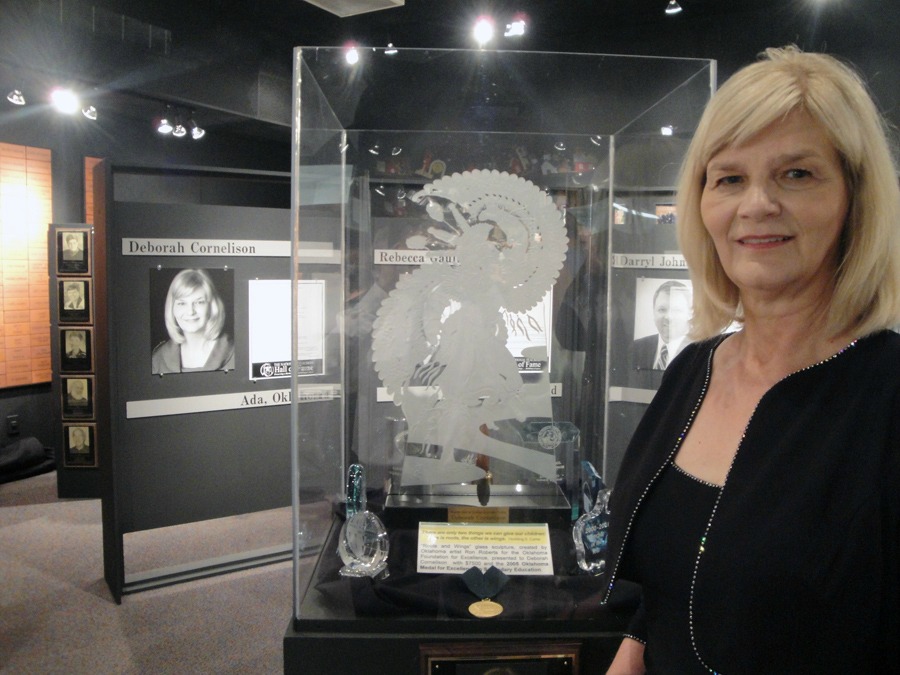Byng teacher and East Central University graduate Deborah Cornelison – along with four educators whose experience combines with hers to total 116 years– was inducted into the National Teachers Hall of Fame in June.
“I was honored by the selection,” Cornelison said. “The induction was very humbling. Thousands and thousands of teachers deserve recognition. Those of us who have been selected for this honor feel like we are representing them.”
Cornelison has taught ninth-grade physical science at Byng Junior High School for most of her 28-year career. She earned a master’s of education in secondary education and bachelor’s in biology and chemistry from ECU. She was an adjunct instructor of general biology and general physical science before taking the job at Byng.
“For a small school, we probably had one of the best biology departments in the state,” Dr. Elmer Brown, professor emeritus of biology and one of Cornelison’s mentors, said. “Schools from all over the area were recruiting science teachers here. We had to be doing something right.”
Her involvement with ECU has been ongoing as Mathematics and Science Partnership Master Teacher, Upward Bound Saturday Science instructor, Upward Bound Regional Math-Science Center Summer Academy instructor of biology, physics and forensics science and Oklahoma State Regents for Higher Education Environmental Science and Astronomy Summer Academy instructor.
“I worked on campus every summer since the early 1990s,” Cornelison said. “So many made an impact on what I was able to accomplish and still able to accomplish.”
Kevin Wilson, a student in her first class and current principal at Byng, knows firsthand how much she deserves the recognition.
“As a student, you knew immediately she meant business,” he said. “She challenged us as much as we have ever been challenged.”
Wilson worked with Cornelison on a daily basis when he taught history and observes her often as principal.
“She is so knowledgeable,” he said. “Nothing catches her off guard. There is no question a student can ask that she can’t answer.”
The National Teachers Hall of Fame – founded in Emporia, Kan. and based on the campus of Emporia State University– is committed to drawing the public's attention to exceptional teachers through a museum, teacher resource center and recognition program which honors five of the nation's most outstanding pre-kindergarten through 12th grade educators each year.
The festivities began on June 11 with the arrival of the five inductees.
“It was a first-class affair,” Cornelison said. “Emporia is really teacher town USA. The whole town came out for all the activities. There were banners on the streets, catered dinners, a band concert.”
The group toured the Sauder Alumni Center, Red Rocks Historic Site, Fremont Park and the headquarters of the National Teachers Hall of Fame itself, where they will be forever celebrated as nationally-recognized inductees and displays, representing their careers, will be showcased for a year.
The five met with high school students from the Future Teachers Academy and attended a groundbreaking at ESU for the National Memorial for Fallen Educators, a 10-by-10-foot black granite monument shaped like a book and inscribed with the names of teachers and staff killed while on the job.
The week culminated with a banquet and induction ceremony where videos each nominee submitted for consideration were shown, followed by remarks from each.
“It was definitely the highlight of my career,” she said.
Cornelison’s nomination resulted from what she considers one of the most important aspects of her career, a strong connection to other colleagues.
Hector Ibarra, a retired science teacher from Iowa she met while attending an environmental educator workshop funded by the Brandwein Institute in New York, placed her name in nomination.
“He recognized what I had done in my career,” she said. “It meant a lot for him to nominate me because his credentials are just amazing.”
She had to submit a written application responding to questions over teaching practices, her views on major issues in education and other documentation for screening by local and national committees, a process Cornelison described as grueling.
“The starting point for selection was some kind of national recognition,” she said.
Cornelison has received over 20 local, state and national awards through the years including the Presidential Award for Excellence in Mathematics and Science Teaching, National Science Teachers
Association/Shell Science Teaching Award, Microsoft Innovative Teacher Best Practice Award and USA Today All-USA Teacher Team Honorable Mention.
Applicants are then narrowed down to semifinalists. Finalists are chosen from three-minute videos showcasing their work.
“It’s challenging to give a big picture of your teaching career in three minutes,” she said.
For Cornelison, it’s all about the students, so most of the video was taken up with short scenes of students in the classroom with her out of the picture questioning, narrating and prodding them to success.
“All of the recognition I have received has been based on the successes of my students,” she said.
Rebecca Gault, sixth-grade language arts teacher from Bel Air Middle School in Bel Air, Md.; Darryl Johnson, 10th- to 12th-grade English/language arts teacher from Smithville High School in Smithville, Mo.; Martha McLeod, fifth-grade science lab instructor/subject area coordinator from Fulton
Fifth and Sixth Grade Learning Center in Rockport, Texas; and Beth Vernon, eighth-grade earth and space science teacher from Brittany Hill Middle School in Blue Springs, Mo. were selected along with Cornelison.
“I have four new friends,” she said. “All of us are still going strong with lots of energy and lots of great ideas. They are doing great things in the classroom so I am looking forward to the association with them in the future.”

